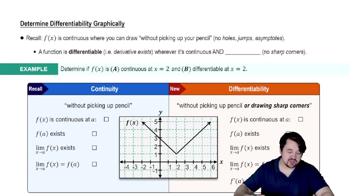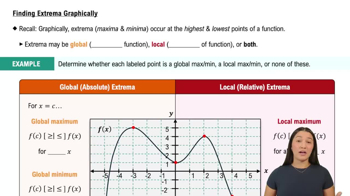Table of contents
- 0. Functions7h 52m
- Introduction to Functions16m
- Piecewise Functions10m
- Properties of Functions9m
- Common Functions1h 8m
- Transformations5m
- Combining Functions27m
- Exponent rules32m
- Exponential Functions28m
- Logarithmic Functions24m
- Properties of Logarithms34m
- Exponential & Logarithmic Equations35m
- Introduction to Trigonometric Functions38m
- Graphs of Trigonometric Functions44m
- Trigonometric Identities47m
- Inverse Trigonometric Functions48m
- 1. Limits and Continuity2h 2m
- 2. Intro to Derivatives1h 33m
- 3. Techniques of Differentiation3h 18m
- 4. Applications of Derivatives2h 38m
- 5. Graphical Applications of Derivatives6h 2m
- 6. Derivatives of Inverse, Exponential, & Logarithmic Functions2h 37m
- 7. Antiderivatives & Indefinite Integrals1h 26m
- 8. Definite Integrals4h 44m
- 9. Graphical Applications of Integrals2h 27m
- 10. Physics Applications of Integrals 2h 22m
5. Graphical Applications of Derivatives
Intro to Extrema
Problem 4.R.2c
Textbook Question
Locating extrema Consider the graph of a function ƒ on the interval [-3, 3]. <IMAGE>
c. Give the approximate coordinates of the inflection point(s) of f.
 Verified step by step guidance
Verified step by step guidance1
Understand that an inflection point is where the function changes concavity, which means the second derivative changes sign.
Examine the graph visually to identify where the curve changes from concave up to concave down or vice versa.
Look for points on the graph where the slope of the tangent line changes from increasing to decreasing or vice versa, indicating a change in concavity.
Estimate the x-coordinate of the inflection point by observing the graph and noting where this change occurs.
Approximate the y-coordinate by finding the corresponding value of the function at the estimated x-coordinate.
 Verified video answer for a similar problem:
Verified video answer for a similar problem:This video solution was recommended by our tutors as helpful for the problem above
Video duration:
2mPlay a video:
Was this helpful?
Key Concepts
Here are the essential concepts you must grasp in order to answer the question correctly.
Inflection Points
Inflection points are points on the graph of a function where the curvature changes direction. This means that the second derivative of the function changes sign at these points. Identifying inflection points is crucial for understanding the behavior of the function, particularly in determining where it transitions from concave up to concave down or vice versa.
Recommended video:

Critical Points
Second Derivative Test
The second derivative test is a method used to determine the concavity of a function at a given point. If the second derivative is positive, the function is concave up, and if it is negative, the function is concave down. An inflection point occurs where the second derivative equals zero or is undefined, indicating a potential change in concavity.
Recommended video:

The Second Derivative Test: Finding Local Extrema
Graphical Analysis
Graphical analysis involves examining the visual representation of a function to identify key features such as extrema, inflection points, and intervals of increase or decrease. By analyzing the graph, one can estimate the coordinates of inflection points and understand the overall behavior of the function across the specified interval.
Recommended video:

Determining Differentiability Graphically

 5:58m
5:58mWatch next
Master Finding Extrema Graphically with a bite sized video explanation from Callie
Start learning





